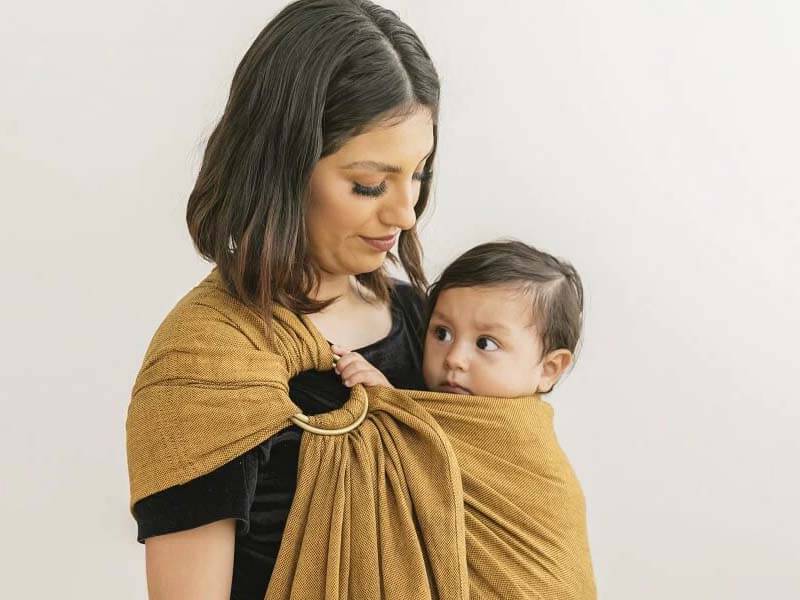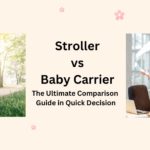The use of baby carriers can be started at any age of your baby. It depends on what time and what age you need it for.
Apart from using the stroller, I used to feel most comfortable using the baby carrier for my kids. Using it felt like I had my child with me. They are designed to keep small children close to their parents.
So, if you are here as a working mom or a homestay mom and have a small baby to hold, this baby carrier is definitely a boon for you. Before you start using a baby carrier, you must understand it well.
Let’s find out exactly when you can use this baby carrier.
Types of Baby Carriers
There are various types of carriers from which you can choose a suitable one to carry your baby. Here are the types of carriers:
1. Soft Structured Career
The Soft Structured Carrier (SSC) has padded shoulder straps and a padded band around your waist for support. Your baby will cling to your chest or back like a frog in this carrier.
The baby should weigh at least 7 pounds to a maximum of 50 pounds.
2. Baby Wraps
Baby wrap carriers mean wrapping the baby with a long piece of cloth and hanging it securely against the chest or back, but there are specific but multiple systems and methods of keeping it this way.
These baby wraps are mainly of three types:
- Stretch wrap (Suitable for newborns to 20 pounds).
- Hybrid wrap (Suitable for newborns to 12 months).
- Woven wrap (Suitable for newborns to 3 years).
- Ring Slings
Ring slings are made of a large piece of cloth with two rings at one end. After placing the baby in the sling, pull the end that does not have a ring and adjust it with the ring. They make breastfeeding easier by carrying the baby.
It is suitable for newborns to 2 years old and weighs 25 pounds.
3. Mei-Tai Carriers
The Mei-Tai carrier combines both wrapping and soft structured features. Its straps wrap around your body, and it has two shoulder straps and two waist straps to support you in carrying the baby.
It is suitable for babies from birth to 44 pounds.
4. Backpack Carriers
When you plan to choose a carrier for your older baby, and you want to go hiking in the mountains, these backpack carriers are perfect for you.
It is suitable for balanced babies who can stand for a long time holding your neck.
Right Time to Use A Baby Carrier
A baby carrier is an essential tool for modern parents like us, who have to juggle a lot of chores and responsibilities in addition to caring for a baby. Depending on the baby’s age, you can carry your baby in different types of carriers as they grow.
Let’s know the general things associated with the right time to use a baby carrier:
Carrying a Newborn to 4 Month Old
When a baby is born on time and healthy, it can be placed in a baby carrier as a newborn after birth. So, if newborns need to be carried in a baby carrier, they should be given extra care and attention.

Here are some crucial guidelines to remember for parents about carrying a newborn in a baby carrier:
- Choosing the right career must: Before buying a carrier, you must first think about the softness of your baby’s body. So, choose a carrier that will provide good support for your baby’s neck and head.
Newborn carriers will have special features such as inserts, support panels, or wraps to keep the baby securely wrapped.
- Pay attention to the baby’s position: When placing the baby in the carrier, ensure that your baby is upright and his face is always visible. Their airways should be unclogged and they can breathe comfortably.
- Is the child comfortable? Check: Observe if your baby feels any discomfort in the carrier. Be on the lookout for signs that she’s uncomfortable since she can’t tell you. So if it feels like this, change its position and give maximum comfort.
If you travel without a car seat in the car using a baby carrier to keep your baby with you, you need to be extra careful not to over-shake your baby.
- Monitor the timing: In the beginning, especially in the first two weeks, it is better not to put your baby in the carrier for long periods.
Keep it short at first, about 15-30 minutes. First, make sure they are comfortable and happy with the carrier.
Since we are talking about putting a newborn in a carrier here, let’s know the advantages of early use of a baby carrier:
- A baby in a carrier is in close physical contact with the parent, which keeps the baby safe and emotionally connected to them.
- This means that the baby’s skin contact with the parent’s skin can regulate the baby’s body temperature and heart rate.
- This allows parents to have both hands open for other responsibilities and tasks.
- For breastfeeding mothers, using a carrier makes it more convenient and comfortable.
- It also provides some support in the development of the baby’s spine and hips.
- Babies cry less when in a carrier if they are comfortable
Additional Tips: If your baby is born prematurely or has health problems, then definitely think before giving it to a carrier. In my opinion, it is best for them not to use the carrier. But if you do, first, consult a healthcare professional.
Carry Your Growing Little One From (4 to 7 months)
After the newborn stage, you may need to switch to a different carrier to carry your growing little one that accommodates their developmental level.
Also, if you want to start using the first carrier for your baby at this age, there are some considerations mentioned below that are important to know:
- Choosing the Adjustable Carrier: Between 4 and 7 months, babies usually have better head control. So then select a carrier for its that is adjustable.
Ensure their settings are secure and comfortably fit, keeping them upright and supporting the entire spine from hip to neck as your little one is still developing physically.
- Interactive carriers: You can also look for carriers that have extra features like mirrors, toys, or interactive elements. They can engage your baby’s senses and keep them entertained while carrying them.
- Carriers with padded shoulder straps: Make sure that at this stage, the carrier has padded shoulder straps and lumbar support for parents.
As your baby gains weight, it is important to distribute the weight evenly to keep the baby in the carrier for a long time.
- Trials are important: Trial different positions in the carriers to see what your little one enjoys the most. Some babies prefer to face inward, and some may enjoy facing outward.
- Monitoring Developmental Needs: At this age, your child’s needs or interests may change as it develops, so pay attention to his needs and adjust the carriers accordingly.
For example, if your baby prefers to sit rather than cling to your chest, choose carriers that have a seated position.

Front-facing and Back Carriers for Children Ages 8 and Up
If you choose to use a baby carrier when your baby is 8 months or older, front-facing and back carriers are perfect for it this time. From 8 months, it becomes stronger and more curious than usual.
Front-facing Carriers: The main feature of front-facing carriers is that they allow your baby to face outwards, giving them a view of the outdoors and promoting interaction with their surroundings.
Choose carriers with adjustable shoulder straps and waist belts to accommodate your baby’s growing size and weight. It ensures a comfortable fit for both you and your baby.
Back Carriers: Back carriers offer an alternative carrying position, allowing your baby to see the outdoors differently. But ensure the back carrier has secure straps and buckles to keep your baby in a snug fit.
These are very important to maintain the baby’s stability and prevent discomfort. Select the appropriate back carrier designed for the age range and weight capacity.
This ensures that your growing baby of 8 months or older in the carrier receives adequate support, especially when you go hiking.

Read more: Stroller Vs Baby Carrier – Make Quick Decesion With This Guide
Final Words
Finally, from my experience, I would say you can start using a baby carrier at any child’s age. Still, your priority should be its safety. So, first, choose a baby carrier according to the comfort and safety of the baby, give it a trial, and then use it.
Your baby may not like the carrier or find it uncomfortable for some reason. In that case, try to figure out if there is any problem with the baby carrier by paying attention to the discomfort of the baby. Wishing you a wonderful time with your baby!
More Resources
Why Baby Jogger City Select Stroller?
How to Remove Car Seat Covers to Wash
9 Common Stroller Problems and How to Overcome Them
5 Tips For Taking A Baby To A Baseball Game
My name is Olivia Brown, and I’m a New York-based blogger and stay-at-home parent. Former business executive enjoying retirement and time with kids Lily and Max. On my blog, I review things for kids and offer my honest thoughts and insights to other parents who may be having the same or similar experiences.





